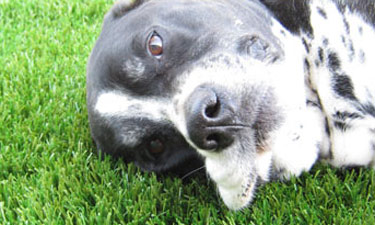 When the Schuylkill River Park Dog Run in Philadelphia decided to resurface the run with K9 grass, some expressed concerns over the suitability of the artificial turf.
When the Schuylkill River Park Dog Run in Philadelphia decided to resurface the run with K9 grass, some expressed concerns over the suitability of the artificial turf.
It is likely that those worried about the safety of K9 grass mistakenly associate Forever Lawn’s K9 grass with its distant cousin, Astroturf. K9 Grass Brand Manager Ken Karmie dispelled this idea: “People are naïve about K9 grass, but it’s designed specifically for dogs. It’s 100 percent permeable for urine, doesn’t hurt paws, and is low maintenance.” The Friends of Schuylkill River Park Dog Run (SRPDR) also highlighted the safety of the grass. In their decision to switch to K9 Grass from mulch, the Friends of the SRPDR noted that “the surface does not puddle, it is clean, does not smell, and the dogs seem to love running on K9 Grass.”
When asked about optimal park conditions for K9 Grass, Karmie paused to consider before explaining, “It’s really ideal in any situation, especially high-traffic urban parks, and suitable for any climate. The turf is low-maintenance, and cleaner—and more aesthetically pleasing—than mulch or gravel, which get dusty and muddy, and can present drainage difficulties.”
Skeptical of these glowing assertions, I spoke with David Arroyo of San Jose Parks and Recreation in California. Forever Lawn’s K9 Grass was installed at San Jose’s Saratoga Creek Dog Park four years ago. Arroyo initially had some reservations about installing the artificial turf because “it was relatively new to our dog park system and I wasn’t sure whether or not the dog park users would like it in the end.” Once the turf was in use, though, Arroyo was impressed. “K9 Grass has been a real success, and has greatly increased the use of the area,” he says. “People are good about cleaning up after their dogs, and we’ve had no issues with maintenance. We rinse and flush three times weekly.”
In Washington, DC’s Bundy Park, park users voted overwhelmingly for K9 Grass over the option of pea gravel, citing that it seemed “more pet-friendly.”
K9 Grass appears to be an ideal fit for small, urban parks like Schuylkill, Saratoga, and Bundy parks. For larger, less-trafficked parks, however, resurfacing with the expensive synthetic turf simply isn’t cost-effective. The 4-acre New Orleans City Bark, for instance, “had looked into turf, but it couldn’t really be considered because of the cost and the size of the park,” a volunteer for the park explained. The park decided to stick with natural grass supplemented by white sand in low areas, and added a concrete walkway for handicap accessibility. Though there is a three-month long downtime during winter months due to the growing cycle of the grass, the natural grass surface has been a “great success.”
Other surfacing options have their own pros and cons. Pea gravel, for instance, can harbor insects and sharp objects. Dust is an issue with both pea gravel and decomposed granite. Rubber matting is difficult to drain, and may foster bacteria. Mulch posed a number of similar issues for Schuylkill and New York City dog parks—the periodic excavation of mulch endangers tree roots, and fungus spores flourishing in mulch can damage a dog’s liver if ingested.
There are a number of factors to consider when surfacing a dog park—park size, traffic concentration, park drainage, to name a few. Choosing the better fit between safe options means balancing cost, maintenance, and long-term durability and depends on individual park circumstances.
Haley Adams is a freelance writer in Washington, DC.

